11- 19 JANUARY 2023
By Sarah Preston
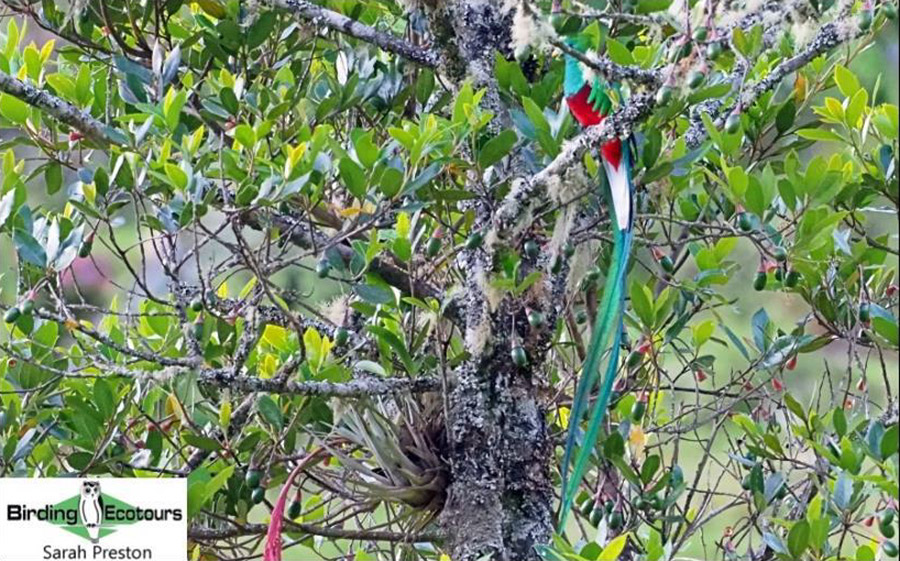
A rapt bunch of birders watched this male Resplendent Quetzal eat its avocado breakfast.
Overview
This Costa Rica Escape 2023 trip was an incredible trip, which allowed us to see the best of the country in just a week. Costa Rica is perhaps the easiest country to bird in the tropical Americas, and most of the Neotropical families are well represented. With great roads, comfortable tourist and service facilities, and modern infrastructure, the country, and this trip in particular, is the best choice for those who come to the tropics for the first time.
Our adventure started in San José, the capital of Costa Rica, and we managed to explore different habitats and ecosystems, ranging from the cloudforest mountains of Savegre in central Costa Rica to the Caribbean foothills. Of the 931 species of birds that occur in Costa Rica we managed to record more than a quarter in a week only! We saw 270 species as well as an additional 18 species that were heard only.
Our trip list included sightings of amazing species such as Resplendent Quetzal, Violet Sabrewing, Black and Crested Guans, Yellow-throated and Keel-billed Toucans, Spectacled and Crested Owls, Flame-throated and Black-cheeked Warblers, Long-tailed Silky-flycatcher, Prong-billed and Red-headed Barbets, American Dipper, Black-breasted Wood Quail, and Golden-Browed Chlorophonia. In addition, we managed to see one of two country endemics that occur on the mainland, Coppery-headed Emerald, and we saw 28 birds that are shared only by Costa Rica and Panama. A nice selection of North American migratory warblers was also found, such as Chestnut-sided, Tennessee, Black-and-white, Golden-winged, Black-throated Green, Townsend’s, and Wilson’s Warblers, 7 species of owls, and 26 species of hummingbirds.
It was a memorable trip, with most participants visiting the tropics for the first time. This fun group of clients was able to experience the excellent food, amazing wildlife, and friendly people that make Costa Rica a popular vacation destination. We hope that you can join us on our Costa Rica Escape 2024 tour!
Detailed Report
Day 1, 11th January 2023. Hotel Bougainvillea
Half the group had arrived at Hotel Bougainvillea by the afternoon, so after lunch we birded the lush gardens behind the hotel. A resident Ferruginous Pygmy-Owl was perched in out in the open and one Mottled Owl was seen roosting in a large stand of bamboo. Several Lesson’s Motmots were seen, and a pair of Red-billed Pigeons were observed in courtship and copulation. Two White-fronted Amazons and a flock of Finsch’s Parakeets flew overhead. That evening a Common Pauraque called loudly in the parking lot and could be heard from inside our rooms.
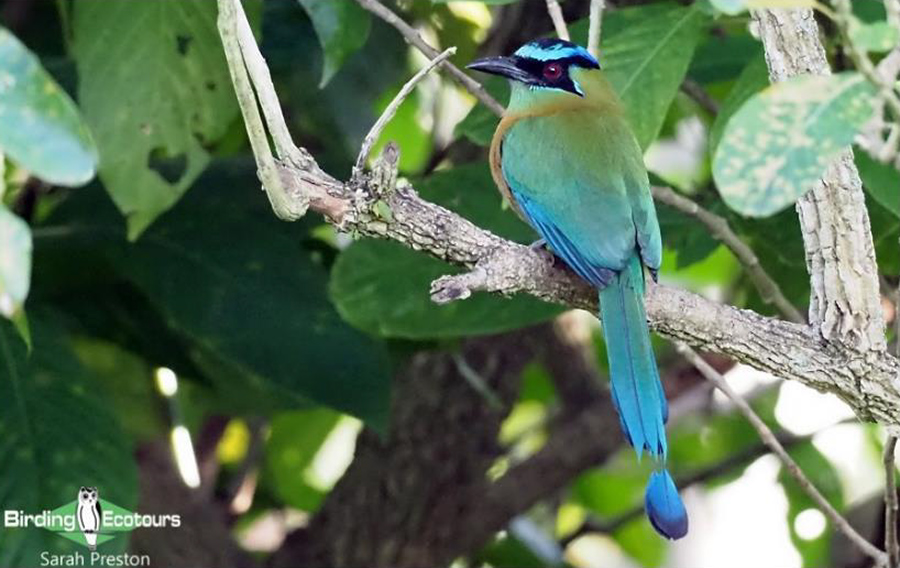
Lesson’s Motmots were actively hunting in the Hotel Bougainvillea garden.
Day 2, 12th January 2023. Irazu Volcano National Park to Savegre Lodge
The group spent the first hour of our first full day birding the gardens behind Hotel Bougainvillea before breakfast. The Ferruginous Pygmy-Owl was again perched in full view and two Mottled Owls were roosting in the bamboo. We tried for White-eared Ground-Sparrow and Chestnut-capped Warbler, which were heard calling and the warbler gave brief views, but neither species cooperated well. Several species perched in the large, leafless tree in the center of the garden: a Masked Tityra, six Brown Jays, and a Tennessee Warbler. A couple Rufous-naped Wrens, a Cabanis’s Wren, and a Rufous-collared Sparrow were observed singing. Just before breakfast a male Montezuma Oropendola flew in and displayed. The female flew in, and they copulated.
After breakfast we drove up into the highlands to Irazu Volcano National Park. At the crater, there were Volcano Juncos in the parking lot. The entire group watched a male Volcano Hummingbird display several times – singing and flying high into the air and coming back to perch. We had our first looks at Slaty Flowerpiercer, Sooty Thrush, Fiery-throated Hummingbird, and Sooty-capped Bush Tanager. When stopped for lunch on the way down the mountain, a Short-tailed Hawk was observed soaring over the valley below.
On the way to Savegre Lodge, we stopped at Miriam’s Quetzals Restaurant where there are feeders in the back and a view of the Savegre Valley. Several species of hummingbirds were coming to the feeder and flowers: Talamanca, Fiery-throated, and Volcano Hummingbirds, Lesser Violetear, and Grey-tailed Mountaingem. The fruit feeder hosted Yellow-thighed Brush-finch, Mountain Thrush, Large-footed Finch, Flame-colored Tanagers, and Acorn Woodpeckers. One of the restaurant staff alerted us to the presence of a male Golden-browed Chlorophonia feeding on crabapples in the side garden and we watched it at length. First looks were had of Ruddy Treerunner and Yellow-winged Vireo, both seen briefly. A male and female pair of Yellow-bellied Siskins were seen perching high behind the feeders.
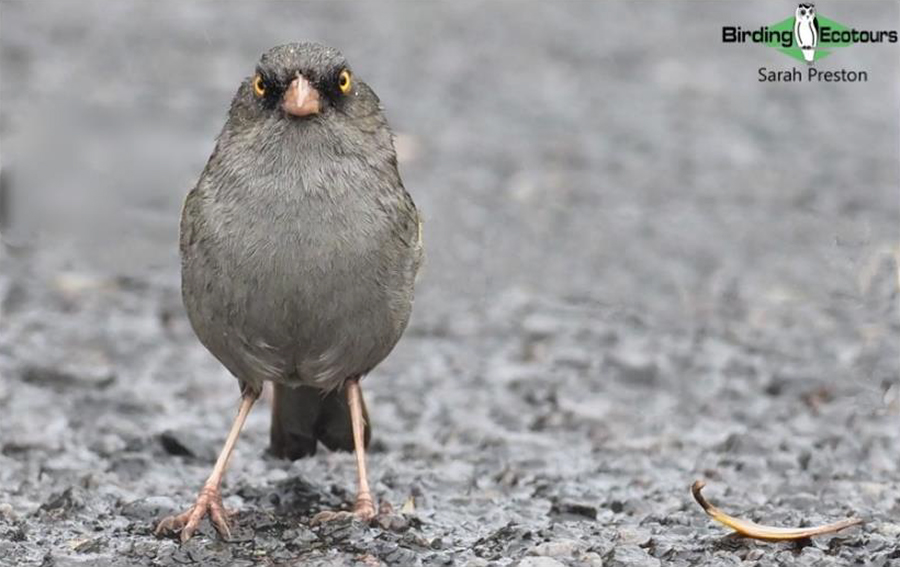
The Volcano Junco’s piercing yellow eyes made it look angry.
We arrived at Savegre Lodge just before dusk and noticed a woman photographing something in a tree at the entrance. When we found out it was an immature male Resplendent Quetzal, we pulled over and everyone eagerly bailed out of the vehicle to see it. Number one species acquired!
Day 3, 13th January 2023. Savegre Lodge to Los Quetzales National Park
We left before dawn to go a few miles down the road to join the vigil for the male Resplendent Quetzal that had been frequenting an avocado tree at dawn. The spectacular bird arrived as if on cue, fed from the avocado tree, and sat still for a long time for excellent scope views. After digesting for at least an hour, it went briefly to the tree again then flew down into the valley and disappeared. Everyone enjoyed seeing its tail stream behind it while it flew. After our breakfast, we took a two-mile walk up the hillside behind the hotel. The variety of species there was impressive! We had close looks at Collared Whitestart and Grey-breasted Wood-Wrens singing, several cooperative Flame-throated Warblers, great looks at two Black-faced Solitaire and Yellowish Flycatcher and encountered a mixed migrant warbler flock that included Wilson’s, Black-throated Green, and Townsend’s Warblers. At least ten White-collared Swifts soared overhead. We enjoyed scope views of Sulphur-winged Parakeets and Barred Becard. We had brief views of an Olive-streaked Flycatcher feeding on berries with a Mountain Elainea and a Philadelphia Vireo until a Spot-crowned Woodcreeper stole our attention. Once back down near the rooms we observed a Scintillant Hummingbird, Long-tailed Silky-Flycatchers, and Slaty Flowerpiercer feeding.
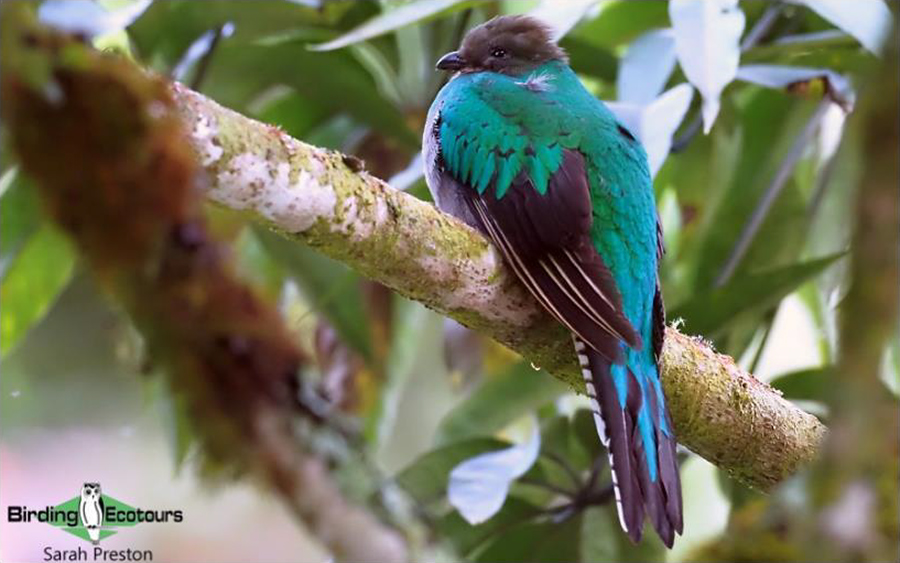
Resplendent Quetzal, the first of two of this most-wanted species seen on the trip.
After lunch we drove to Villa Mills, which is above 9,000 feet elevation. At the beginning of the trail, a keen tour participant found an endemic Black-cheeked Warbler and there turned out to be three of them. A Timberline Wren was singing but didn’t come out. We did get views of several Black-billed Nightingale-Thrush, which were also singing. We saw the hilarious looking Buffy Tuftedcheek and got better views of Ruddy Treerunner.
We moved on from there a short distance down the mountain to a gravel road within Los Quetzales National Park. We found a perched Talamanca Hummingbird and a Grey-tailed Mountaingem preparing to roost for the night, offering fantastic looks. Just at dusk, the Dusky Nightjar began calling. It flew up to a branch right above the road and perched for several minutes, offering phenomenal views, until a car flushed it. As it flew, the buffy corners of the tail could be seen. After this, we tried for the endemic Bare-shanked Screech-Owl, which was quite cooperative, and everyone got amazing looks of the owl perched in the open.
Day 4, 14th January 2023. Parque Nacional Los Quetzals and San Gerardo de Dota Sendero Catarata
We took our customary morning walk, this time along Río Savegre, and saw several Torrent Tyrranulets, including a pair possibly setting up nesting territory. The small black, gray, and white flycatchers were fun to watch moving around the rocks on the river, occasionally flying up for an insect. A Stripe-tailed Hummingbird was feeding on flowers alongside the road allowing for good looks at its namesake and a silent Belted Kingfisher rocketed down the river. We got our first looks at Common Bush Tanager and compared them to nearby Sooty-capped Bush Tanager. On the way back, we admired a flock of Long-tailed Silky-Flycatchers.
After breakfast, we visited Parque Nacional Los Quetzals and encountered a mixed flock of species previously seen that included Barred Becard. Timberline Wren was seen at last, three individuals together. We watched a pair of Black-capped Flycatchers actively foraging and had scope views of Mistletoe Tyrannulet and of a pair of Black-and-yellow Phainoptila. A Wrenthrush was calling and did get very near the group, but didn’t come out, only its movement was seen. We had a fantastically close look at a male Volcano Hummingbird (heliotrope-throated subspecies). A Ruddy Pigeon called “mashed potatoes” in the distance, but never came close.
We stopped for lunch and hummingbird photos at Paraíso Quetzal Lodge. There we had ridiculously close encounters with Volcano, Fiery-throated, Talamanca Hummingbirds, Lesser Violetear, and Grey-tailed Mountaingem. A male Volcano Hummingbird was displaying nearby. We had a second look at Golden-browed Chlorophonia when a pair perched in a treetop eye-level to the platform.
In the late afternoon, we hiked the San Gerardo de Dota Sendero Catarata (Waterfall Trail). It was exciting to see two pairs of American Dippers foraging underwater for insects in the river as well as Dark Pewee, endemic to Costa Rica and western Panama, and two Tufted Flycatchers hawking insects. We had brief encounters with Ochraceous Wren, Red-faced Spinetail, Black-thighed Grosbeak, and Spotted Barbtail and a long look at a singing Ruddy-capped Nightingale-Thrush at dusk and spotted another one as we exited the trail.
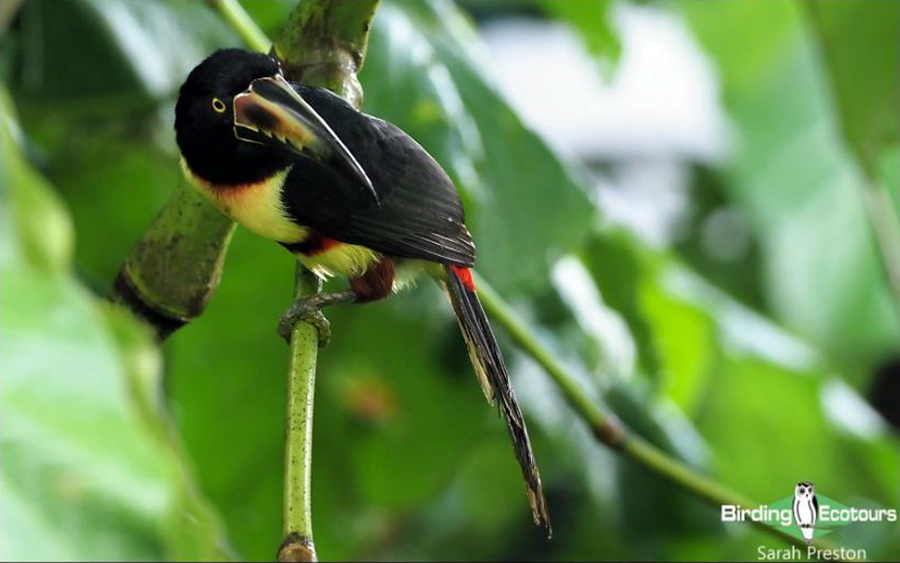
Collared Aracari were common, but attractive, guests at several fruit feeders we visited.
Day 5, 15th January 2023.Rio San José and Comandancia de Sarapiquí Road
We took one last pre-breakfast walk around Savegre before heading to La Quinta Sarapiquí Lodge where we would stay the next three nights. We got our first view of Slate-throated Whitestart, albeit brief. The highlight of the walk was the discovery of a Lesser Violetear nest with two young, especially when a parent came and fed them.
Since the weather wasn’t favorable the day before, we returned to Parque Nacional Los Quetzals. A White-fronted Tyrannulet was seen several times moving about. The main target, missed yesterday, was the Costa Rican Pygmy-Owl, endemic to the Costa Rican and western Panamanian highlands, which we ended up seeing in full view for several minutes to our amazement.
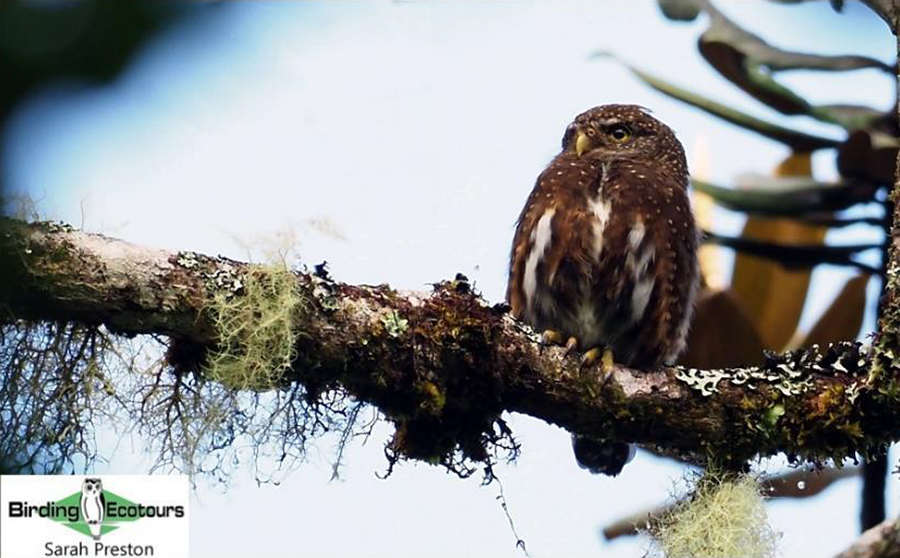
Viewing this endemic Costa Rican Pygmy-Owl was a truly unforgettable experience.
We made a stop after lunch to bird Calle Israel along Rio San José. We eventually got fantastic views of the main target, Fasciated Tiger-Heron, which flushed at first, but then two were viewed well from the vehicle. A Spotted Sandpiper, a juvenile Little Blue Heron, a Northern Waterthrush and Buff-rumped Warblers were also feeding along the river. We had first looks at Collared Aracari feeding in a fruiting tree. An Amazon Kingfisher that flew down the river was viewed by some as it perched briefly. Scope views of White-crowned Parrots were also had.
A few new species were added on the drive. A small pond along the road yielded some waders on the way to Sarapiquí: Great-Blue Heron, Northern Jacana, and Great Egret. Cattle Egrets and Groove-billed Ani were seen as we drove by fields and scrub habitat.
Our last stop of the day was Comandancia de Sarapiquí Road, an open area with a few very large trees. The big draw here was the Great Green and Scarlet Macaws and both species were seen in flight. One Scarlet Macaw perched high, but in the open. A pair of Bat Falcons were also perched high, at the top of a tree. A soaring Short-tailed Hawk gave distant views. A pair of Slaty Spinetails were observed nest building. Common Tody-Flycatcher came in close for a great photographic opportunity. Two Black-striped Sparrows were calling and occasionally came into view. Several other flycatcher species were observed: Grey-capped Flycatcher, Tropical Kingbird, Great Kiskadee, Northern Tropical Pewee, and Mistletoe Tyrannulet. Many Montezuma and three Chestnut-headed Oropendolas flew overhead. Variable Seedeaters were mimicking a variety of other birds’ songs and flocking with a Morelet’s Seedeater.
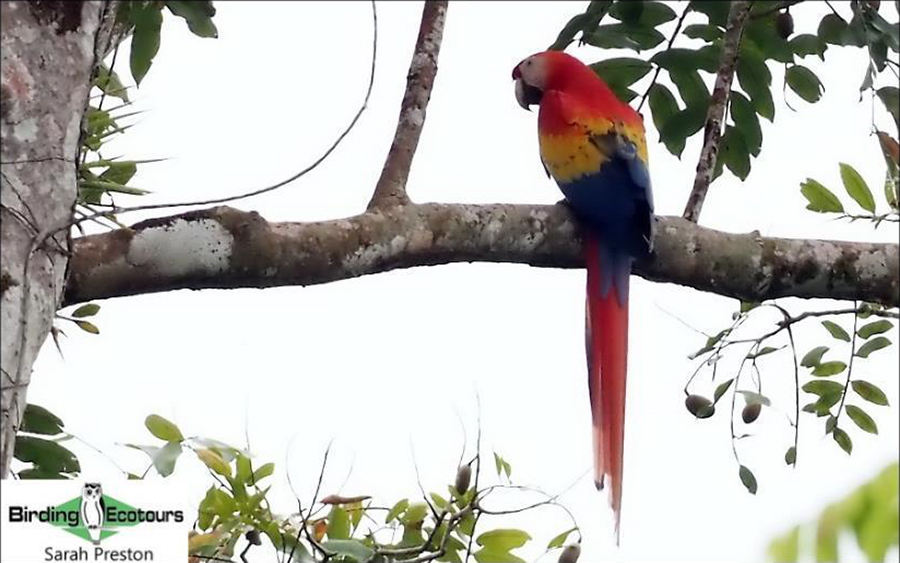
It was awe-inspiring to see wild Scarlet Macaws.
Day 6, 16th January 2023. La Quinta Sarapiquí Lodge, Cope’s Place and La Quinta
Excited to bird a new location, we took our usual walk before breakfast around La Quinta Sarapiquí Lodge and immediately encountered a new species, a cooperative Stripe-breasted Wren. Near the Caiman lake, we found a couple Orange-billed Sparrows, a Northern Waterthrush, a Buff-rumped Warbler, and a Green Kingfisher. In the woods, a Slate-colored Grosbeak called from high in the trees. We had brief looks at a female Blue-black Grosbeak and would later also get glimpses of the male. The two feeders on the property hosted a variety of species including Clay-colored Thrush, Green and Red-legged Honeycreeper, Black-cheeked Woodpecker, Rufous-tailed Hummingbird, Grey-headed Chachalaca, Red-throated Ant Tanager,and Palm, Scarlet-rumped, and Golden-Hooded Tanagers.
After breakfast, we headed to Cope’s Place. On the way we paused for great looks at a Grey Hawk on a pole. As soon as we arrived, we were treated to a perched Band-tailed Barbthroat. We spent an hour at Cope’s feeders watching and photographing Long-billed and Striped-throated Hermits, Shining, Green, and Red-legged Honeycreepers, a Bronze-tailed Plumeleteer, a Green-breasted Mango, many White-necked Jacobins, and Chestnut-headed and Montezuma Oropendolas. We got our first close looks at Pale-vented Pigeons and Orange-chinned Parakeets, previously fly overs, and saw our first Keel-billed Toucan, which came to the bananas. A Russet-naped Wood-Rail came out and ate the rice. We also enjoyed talking with Cope and looking at his amazing photographs and artwork.
We took a walk in Cope’s farm with one of the guides who showed us a colony of Honduran White Bats roosting under a huge leaf. Early in the walk we had brief looks at a pair of Cinnamon Woodpecker and good looks at two Scarlet-rumpled Caciques. We were amazingly fortunate to see and photograph two Crested Owls perched together and an immature Spectacled Owl. We also viewed two Green Ibis. On the way out, we marveled over a huge Bullet Ant on a log.
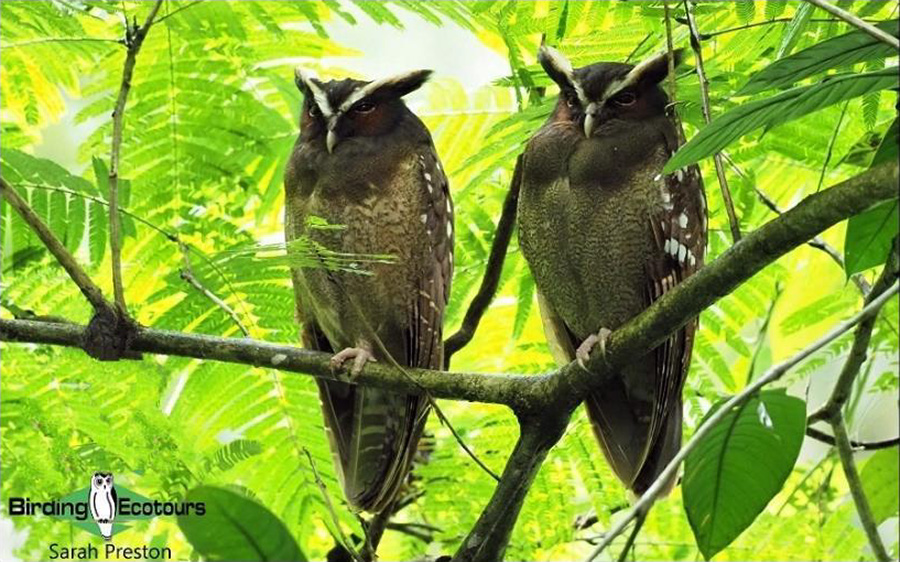
We counted ourselves lucky to see this pair of Crested Owls right out in the open.
After lunch and a break, we had planned to drive to an open area close to La Quinta. We stopped for five Southern Lapwings in a field and also saw a pair of Lineated Woodpeckers there. We never got to the intended location because next we stopped for a probable Motmot and ended up finding 46 species at the “Crazy Corner” and never did get a motmot. Highlights included three species of Antshrike, all seen very well: Great (singing male), Fasciated (male and female), and Barred Antshrike (male and female). We had spectacular views of Squirrel Cuckoo, Black-crowned Tityra,a singing Rufous-tailed Jacamar, and Canebrake Wren. We watched a Long-tailed Tyrant sally for insects. Three Giant Cowbirds flew over and one perched briefly.
In the evening we went searching for nocturnal creatures and found a Common Rain Frog, a Slender Anole, a Cane Toad, a Long-nosed Proboscis Bat, and several Spectacled Caiman.
Day 7, 17th January 2023. La Selva Biological Station
A big day with 92 species recorded!
We birded around La Quinta before breakfast and picked up Purple-crowned Fairy and Black-cowled Orioles, new for the trip.
We spent the rest of the morning at La Selva Biological Station. The variety of birds just at the headquarters was amazing and included several Short-billed Pigeons, nesting Olive-backed Euphonia and Crested Guans, a soaring Double-toothed Kite, a female White-ruffed Manakin, and a male White-collared Manakin. Once in the jungle, woodpeckers were a highlight with a nest-building Chestnut-colored Woodpecker and Pale-billed Woodpeckers feeding young. Some in the group enjoyed their lifer look at a Kentucky Warbler while others worked to identify a Streak-headed Woodcreeper. The morning included notable mammal sightings: a troop of Golden-mantled Howler Monkeys and two Brown-throated Three-toed Sloths. Just before a pre-lunch snack of fresh watermelon and pineapple, we added Black-headed Tody-Flycatcher and Cinnamon Becard to our list of birds seen well.
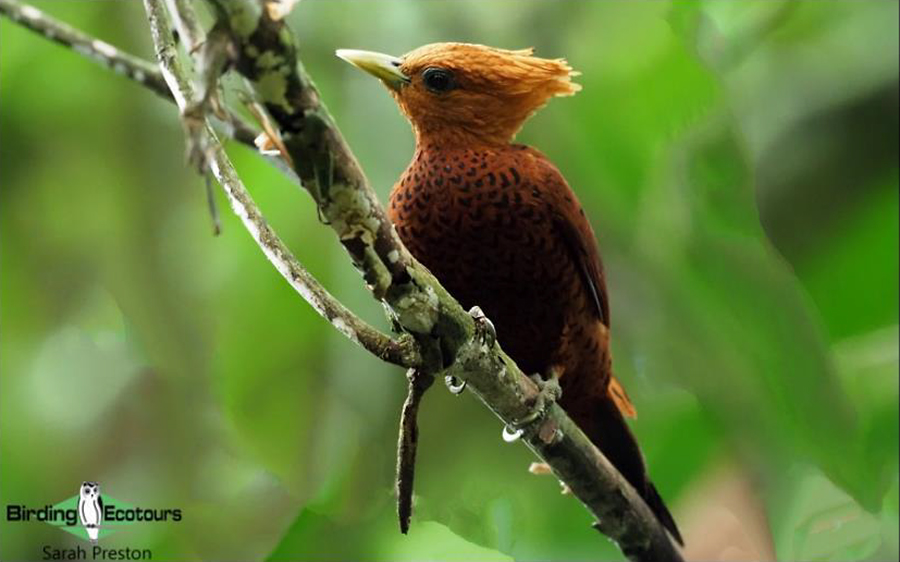
Watching woodpecker nesting activities, including Chestnut-colored Woodpeckers, was a treat.
After lunch and a break, we returned to La Selva Biological Station until dusk. Upon arrival, we had brief views of a Bay-headed Tanager and a male Snowy Cotinga and a Scarlet-thighed Dacnis were perched in the open for excellent scope views. Then several Yellow-throated and Keel-billed Toucans and a group of Red-lored Amazons flew in. From the bridge, we viewed our first White-ringed Flycatcher,a Rufous Mourner,and a Slaty-tailed Trogon giving fantastic views perched in the open, eye-level to the bridge. Just after crossing the bridge, the only Blue-chested Hummingbird of the trip was seen foraging in a large flowering tree. The same area also hosted Social, Grey-capped,and Boat-billed Flycatchers.While walking the trail, a male Great Tinamou and three chicks walked across the trail in front of us. At dusk, a pair of Middle American Screech-Owls were calling, and one was cooperative, allowing for excellent views.
Day 8, 18th January 2023. La Selva to San Jose
We had a goal to break 100 species for our last birding day and we did it!
We started early to begin birding the road near the main entrance to La Selva before dawn. While it was still dark, we saw several Common Pauraque foraging for insects in the streetlight and heard a Little Tinamou calling. At dawn, we observed a Short-tailed Nighthawk flying around.
After dawn, we observed many birds from a spot just outside the main entrance including a close, perched Semiplumbeous Hawk, an Ochre-bellied Flycatcher, a Southern Rough-winged Swallow, many Collared Aracaris and Yellow-throated Toucans, a Keel-billed Toucan, a Brown-hooded and several Red-lored Amazons, and a flock of Orange-chinned Parakeets. At one point, we heard a Slaty-breasted Tinamou that sounded like a mini train and very close by, so we investigated, but it was like a ghost. Our foray into the forest wasn’t for naught, though, because we saw several Wedge-billed Woodcreepers and a Cocoa Woodcreeper at that time. The trail led us to an open area where we added two new species: a Bronzy Hermit and a pair of Olive-crowned Yellowthroats.
It was time to return to the lodge for breakfast, but two spontaneous birding stops were a necessity. First, we stopped for seven Scarlet Macaws in a single tree by the road. Then just before the lodge, we saw a Broad-billed Motmot on a wire and got two noisy Bright-rumped Attilas as a bonus.
After breakfast we bid goodbye to La Quinta and headed to San Jose, but not before watching a Strawberry Poison-dart Frog sing right outside our rooms.
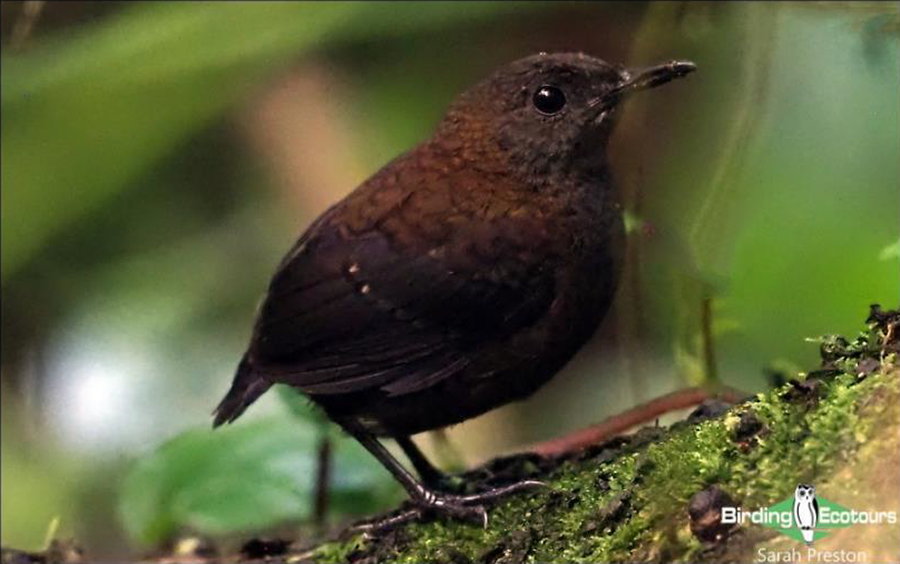
Nightingale Wren, a shy, plain bird that put on a show.
We made several birding stops at different elevations, the most productive of those was Virgin del Socorro and we hated to leave. On the drive down into the valley we spotted a Slaty-backed Nightingale-Thrush and a Lesser Greenlet was the first bird we spied at the bottom. We saw many flycatcher species and added these new ones to our list: Slaty-capped Flycatcher, Scale-crested Pygmy-Tyrant, and Eye-ringed Flatbill. Warblers were actively feeding, and we added Tropical Parula, Blackburnian and Golden-crowned Warblers to our list and got a second look at Golden-winged Warbler and Slated-throated Whitestart here. A large flock of vultures soaring over the valley included all three species: King, Black, and Turkey Vulture. One keen-eyed participant got a long look at a Chestnut-backed Antbird, which played hide and seek with the rest of the group. More cooperative birds included an Olivaceous Woodcreeper, three Black-thighed Grosbeaks, a Collared Trogon perched in the open, and a Nightingale Wren that showed itself and put on quite the concert within a few feet of the entire group.
On the way up to the Cinchona Feeders we stopped for a much better view of a pair of Bat Falcons than before and a brief look at a large group of White-nosed Coati being fed by gullible tourists.
The Cinchona Feeders were an obligatory stop for both the waterfall overlook view and the amazing birds. We picked up our three main targets for this location almost immediately: Red-headed and Prong-billed Barbets, and two Blue-throated Toucanets. We also got first looks at Green Hermit and Green-Crowned Brilliant, a second sighting of Crimson-collared Tanager, our sole sighting of Black-headed Saltator, and our only rare bird of the trip, Yellow-winged Tanager, which has somewhat recently expanded its range southward into Costa Rica.
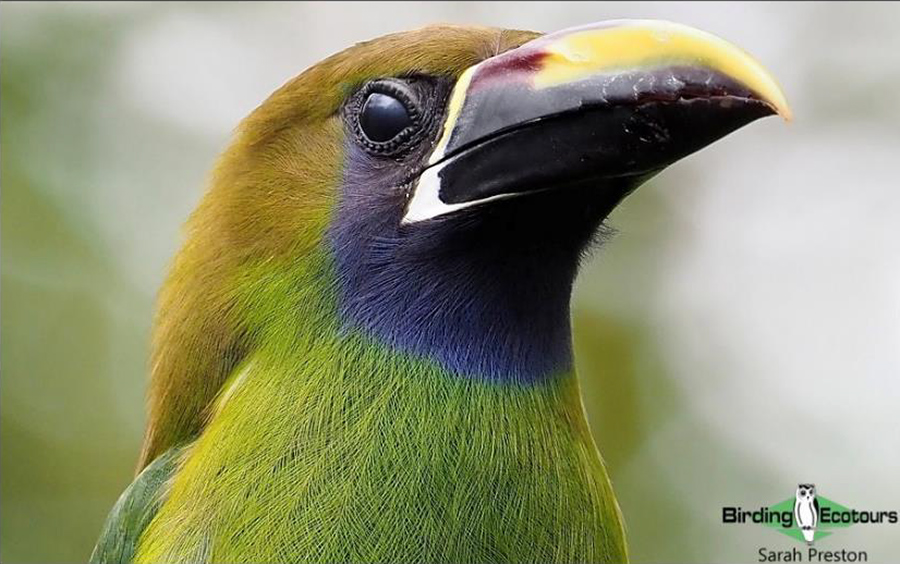
A beautiful pair of Blue-throated Toucanets were the stars of the Cinchona Feeders.
We stopped at La Paz Waterfall Gardens for both birds and lunch. One of two major targets was obtained while eating, the Sooty-faced Finch, an individual known to beg rice from diners and a species otherwise very difficult to see. The group was practically bum rushed by a flock of eight of the other target, Black-breasted Wood-Quail, when they noisily crossed the set of stairs where we were standing. Several new-for-the-trip hummingbirds were viewed at the many feeders: Green Thorntail, White-bellied and Purple-throated Mountaingems, Black-bellied Hummingbird,and Coppery-headed Emerald. On the way out, a participant that was lagging behind the group snagged the only Tawny-capped Euphonia and last new species of the trip.
Day 9, 19th January 2023. Departure
Our international flights left from Juan Santamaría International Airport.
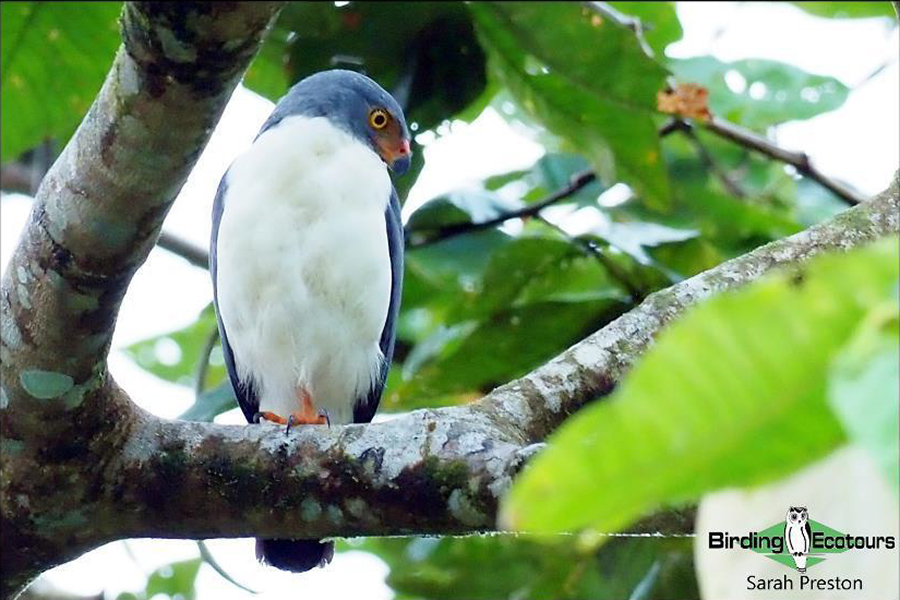
This Semiplumbeous Hawk perched nearby, undetected until the birds gave it away.
Bird List – Following IOC (12.2)
Birds ‘heard only’ are marked with (H) after the common name, all other species were seen.
The following notation after species names is used to show conservation status following
BirdLife International: CE = Critically Endangered, EN = Endangered, VU = Vulnerable, NT
= Near Threatened.
| Common Name | Scientific Name | ||
| Tinamous (Tinamidae) | |||
| Great Tinamou | Tinamus major | ||
| Little Tinamou (H) | Crypturellus soui | ||
| Slaty-breasted Tinamou – VU (H) | Crypturellus boucardi | ||
| Chachalacas, Curassows, Guans (Cracidae) | |||
| Grey-headed Chachalaca | Ortalis cinereiceps | ||
| Crested Guan | Penelope purpurascens | ||
| Black Guan | Chamaepetes unicolor | ||
| New World Quail (Odontophoridae) | |||
| Black-breasted Wood Quail | Odontophorus leucolaemus | ||
| Spotted Wood Quail (H) | Odontophorus guttatus | ||
| Nightjars (Caprimulgidae) | |||
| Short-tailed Nighthawk | Lurocalis semitorquatus | ||
| Pauraque | Nyctidromus albicollis | ||
| Dusky Nightjar | Antrostomus saturatus | ||
| Swifts (Apodidae) | |||
| White-collared Swift | Streptoprocne zonaris | ||
| Grey-rumped Swift | Chaetura cinereiventris | ||
| Vaux’s Swift | Chaetura vauxi | ||
| Lesser Swallow-tailed Swift | Panyptila cayennensis | ||
| Hummingbirds (Trochilidae) | |||
| White-necked Jacobin | Florisuga mellivora | ||
| Bronzy Hermit | Glaucis aeneus | ||
| Band-tailed Barbthroat | Threnetes ruckeri | ||
| Stripe-throated Hermit | Phaethornis striigularis | ||
| Green Hermit | Phaethornis guy | ||
| Long-billed Hermit | Phaethornis longirostris | ||
| Lesser Violetear | Colibri cyanotus | ||
| Purple-crowned Fairy | Heliothryx barroti | ||
| Green-breasted Mango | Anthracothorax prevostii | ||
| Green Thorntail | Discosura conversii | ||
| Green-crowned Brilliant | Heliodoxa jacula | ||
| Talamanca Hummingbird | Eugenes spectabilis | ||
| Fiery-throated Hummingbird | Panterpe insignis | ||
| White-bellied Mountaingem | Lampornis hemileucus | ||
| Purple-throated Mountaingem | Lampornis calolaemus | ||
| Grey-tailed Mountaingem (Endemic) | Lampornis cinereicauda | ||
| Ruby-throated Hummingbird | Archilochus colubris | ||
| Volcano Hummingbird | Selasphorus flammula | ||
| Scintillant Hummingbird | Selasphorus scintilla | ||
| Violet Sabrewing | Campylopterus hemileucurus | ||
| Bronze-tailed Plumeleteer | Chalybura urochrysia | ||
| Coppery-headed Emerald (Endemic) | Microchera cupreiceps | ||
| Stripe-tailed Hummingbird | Eupherusa eximia | ||
| Black-bellied Hummingbird | Eupherusa nigriventris | ||
| Rufous-tailed Hummingbird | Amazilia tzacatl | ||
| Blue-chested Hummingbird | Polyerata amabilis | ||
| Cuckoos (Cuculidae) | |||
| Groove-billed Ani | Crotophaga sulcirostris | ||
| Squirrel Cuckoo | Piaya cayana | ||
| Pigeons, Doves (Columbidae) | |||
| Rock Dove (Introduced) | Columba livia | ||
| Scaled Pigeon | Patagioenas speciosa | ||
| Band-tailed Pigeon | Patagioenas fasciata | ||
| Pale-vented Pigeon | Patagioenas cayennensis | ||
| Red-billed Pigeon | Patagioenas flavirostris | ||
| Ruddy Pigeon (H) | Patagioenas subvinacea | ||
| Short-billed Pigeon | Patagioenas nigrirostris | ||
| Inca Dove | Columbina inca | ||
| Ruddy Ground Dove | Columbina talpacoti | ||
| Blue Ground Dove (H) | Claravis pretiosa | ||
| White-tipped Dove | Leptotila verreauxi | ||
| Grey-chested Dove | Leptotila cassinii | ||
| White-winged Dove | Zenaida asiatica | ||
| Rails, Crakes & Coots (Rallidae) | |||
| Russet-naped Wood Rail | Aramides albiventris | ||
| Plovers (Charadriidae) | |||
| Southern Lapwing | Vanellus chilensis | ||
| Jacanas (Jacanidae) | |||
| Northern Jacana | Jacana spinosa | ||
| Sandpipers, Snipes (Scolopacidae) | |||
| Spotted Sandpiper | Actitis macularius | ||
| Anhingas, Darters (Anhingidae) | |||
| Anhinga | Anhinga anhinga | ||
| Ibises, Spoonbills (Threskiornithidae) | |||
| Green Ibis | Mesembrinibis cayennensis | ||
| Herons, Bitterns (Ardeidae) | |||
| Fasciated Tiger Heron | Tigrisoma fasciatum | ||
| Green Heron | Butorides virescens | ||
| Western Cattle Egret | Bubulcus ibis | ||
| Great Blue Heron | Ardea herodias | ||
| Great Egret | Ardea alba | ||
| Little Blue Heron | Egretta caerulea | ||
| New World Vultures (Cathartidae) | |||
| King Vulture | Sarcoramphus papa | ||
| Black Vulture | Coragyps atratus | ||
| Turkey Vulture | Cathartes aura | ||
| Kites, Hawks, Eagles (Accipitridae) | |||
| Double-toothed Kite | Harpagus bidentatus | ||
| Roadside Hawk (H) | Rupornis magnirostris | ||
| Semiplumbeous Hawk | Leucopternis semiplumbeus | ||
| Grey Hawk | Buteo plagiatus | ||
| Broad-winged Hawk | Buteo platypterus | ||
| Short-tailed Hawk | Buteo brachyurus | ||
| Red-tailed Hawk | Buteo jamaicensis | ||
| Owls (Strigidae) | |||
| Costa Rican Pygmy Owl | Glaucidium costaricanum | ||
| Ferruginous Pygmy Owl | Glaucidium brasilianum | ||
| Bare-shanked Screech Owl | Megascops clarkii | ||
| Vermiculated Screech Owl | Megascops vermiculatus | ||
| Spectacled Owl | Pulsatrix perspicillata | ||
| Crested Owl | Lophostrix cristata | ||
| Mottled Owl | Strix virgata | ||
| Trogons (Trogonidae) | |||
| Resplendent Quetzal | Pharomachrus mocinno | ||
| Slaty-tailed Trogon | Trogon massena | ||
| Collared Trogon | Trogon collaris | ||
| Kingfishers (Alcedinidae) | |||
| Amazon Kingfisher | Chloroceryle amazona | ||
| Green Kingfisher | Chloroceryle americana | ||
| Belted Kingfisher | Megaceryle alcyon | ||
| Motmots (Momotidae) | |||
| Lesson’s Motmot | Momotus lessonii | ||
| Broad-billed Motmot | Electron platyrhynchum | ||
| Jacamars (Galbulidae) | |||
| Rufous-tailed Jacamar | Galbula ruficauda | ||
| New World Barbets (Capitonidae) | |||
| Red-headed Barbet | Eubucco bourcierii | ||
| Toucan Barbets (Semnornithidae) | |||
| Prong-billed Barbet | Semnornis frantzii | ||
| Toucans (Ramphastidae) | |||
| Blue-throated Toucanet | Aulacorhynchus caeruleogularis | ||
| Collared Aracari | Pteroglossus torquatus | ||
| Keel-billed Toucan | Ramphastos sulfuratus | ||
| Yellow-throated Toucan | Ramphastos ambiguus | ||
| Woodpeckers (Picidae) | |||
| Acorn Woodpecker | Melanerpes formicivorus | ||
| Black-cheeked Woodpecker | Melanerpes pucherani | ||
| Hoffmann’s Woodpecker | Melanerpes hoffmannii | ||
| Cinnamon Woodpecker | Celeus loricatus | ||
| Chestnut-colored Woodpecker | Celeus castaneus | ||
| Lineated Woodpecker | Dryocopus lineatus | ||
| Pale-billed Woodpecker | Campephilus guatemalensis | ||
| Caracaras, Falcons (Falconidae) | |||
| Crested Caracara | Caracara plancus | ||
| Collared Forest Falcon (H) | Micrastur semitorquatus | ||
| Bat Falcon | Falco rufigularis | ||
| African & New World Parrots (Psittacidae) | |||
| Orange-chinned Parakeet | Brotogeris jugularis | ||
| Brown-hooded Parrot | Pyrilia haematotis | ||
| White-crowned Parrot | Pionus senilis | ||
| White-fronted Amazon | Amazona albifrons | ||
| Red-lored Amazon | Amazona autumnalis | ||
| Sulphur-winged Parakeet | Pyrrhura hoffmanni | ||
| Olive-throated Parakeet | Eupsittula nana | ||
| Great Green Macaw – CR | Ara ambiguus | ||
| Scarlet Macaw | Ara macao | ||
| Finsch’s Parakeet | Psittacara finschi | ||
| Ovenbirds (Furnariidae) | |||
| Olivaceous Woodcreeper | Sittasomus griseicapillus | ||
| Wedge-billed Woodcreeper | Glyphorynchus spirurus | ||
| Cocoa Woodcreeper | Xiphorhynchus susurrans | ||
| Streak-headed Woodcreeper | Lepidocolaptes souleyetii | ||
| Spot-crowned Woodcreeper | Lepidocolaptes affinis | ||
| Buffy Tuftedcheek | Pseudocolaptes lawrencii | ||
| Spotted Barbtail | Premnoplex brunnescens | ||
| Ruddy Treerunner | Margarornis rubiginosus | ||
| Red-faced Spinetail | Cranioleuca erythrops | ||
| Slaty Spinetail | Synallaxis brachyura | ||
| Antbirds (Thamnophilidae) | |||
| Barred Antshrike | Thamnophilus doliatus | ||
| Black-crowned Antshrike (H) | Thamnophilus atrinucha | ||
| Fasciated Antshrike | Cymbilaimus lineatus | ||
| Great Antshrike | Taraba major | ||
| Spotted Antbird (H) | Hylophylax naevioides | ||
| Chestnut-backed Antbird | Poliocrania exsul | ||
| Tyrant Flycatchers, Calyptura (Tyrannidae) | |||
| White-fronted Tyrannulet | Phyllomyias zeledoni | ||
| Mountain Elaenia | Elaenia frantzii | ||
| Torrent Tyrannulet | Serpophaga cinerea | ||
| Mistletoe Tyrannulet | Zimmerius parvus | ||
| Olive-striped Flycatcher | Mionectes olivaceus | ||
| Ochre-bellied Flycatcher | Mionectes oleagineus | ||
| Slaty-capped Flycatcher | Leptopogon superciliaris | ||
| Scale-crested Pygmy Tyrant | Lophotriccus pileatus | ||
| Common Tody-Flycatcher | Todirostrum cinereum | ||
| Black-headed Tody-Flycatcher | Todirostrum nigriceps | ||
| Eye-ringed Flatbill | Rhynchocyclus brevirostris | ||
| Black Phoebe | Sayornis nigricans | ||
| Northern Tufted Flycatcher | Mitrephanes phaeocercus | ||
| Dark Pewee | Contopus lugubris | ||
| Ochraceous Pewee (H) | Contopus ochraceus | ||
| Tropical Pewee | Contopus cinereus | ||
| Yellow-bellied Flycatcher (H) | Empidonax flaviventris | ||
| Yellowish Flycatcher | Empidonax flavescens | ||
| Black-capped Flycatcher | Empidonax atriceps | ||
| Long-tailed Tyrant | Colonia colonus | ||
| Piratic Flycatcher | Legatus leucophaius | ||
| Social Flycatcher | Myiozetetes similis | ||
| Grey-capped Flycatcher | Myiozetetes granadensis | ||
| Great Kiskadee | Pitangus sulphuratus | ||
| White-ringed Flycatcher | Conopias albovittatus | ||
| Boat-billed Flycatcher | Megarynchus pitangua | ||
| Tropical Kingbird | Tyrannus melancholicus | ||
| Rufous Mourner | Rhytipterna holerythra | ||
| Great Crested Flycatcher (H) | Myiarchus crinitus | ||
| Bright-rumped Attila | Attila spadiceus | ||
| Cotingas (Cotingidae) | |||
| Snowy Cotinga | Carpodectes nitidus | ||
| Manakins (Pipridae) | |||
| White-ruffed Manakin | Corapipo altera | ||
| White-collared Manakin | Manacus candei | ||
| Red-capped Manakin | Ceratopipra mentalis | ||
| Tityras, Becards, Sharpbill (Tityridae) | |||
| Black-crowned Tityra | Tityra inquisitor | ||
| Masked Tityra | Tityra semifasciata | ||
| Barred Becard | Pachyramphus versicolor | ||
| Cinnamon Becard | Pachyramphus cinnamomeus | ||
| Vireos, Greenlets, Shrike-babblers (Vireonidae) | |||
| Rufous-browed Peppershrike (H) | Cyclarhis gujanensis | ||
| Lesser Greenlet | Pachysylvia decurtata | ||
| Philadelphia Vireo | Vireo philadelphicus | ||
| Yellow-winged Vireo | Vireo carmioli | ||
| Crows, Jays (Corvidae) | |||
| Brown Jay | Psilorhinus morio | ||
| Silky-flycatchers (Ptiliogonatidae) | |||
| Black-and-yellow Phainoptila | Phainoptila melanoxantha | ||
| Long-tailed Silky-flycatcher | Ptiliogonys caudatus | ||
| Swallows, Martins (Hirundinidae) | |||
| Mangrove Swallow | Tachycineta albilinea | ||
| Blue-and-white Swallow | Pygochelidon cyanoleuca | ||
| Northern Rough-winged Swallow | Stelgidopteryx serripennis | ||
| Southern Rough-winged Swallow | Stelgidopteryx ruficollis | ||
| Grey-breasted Martin | Progne chalybea | ||
| Barn Swallow | Hirundo rustica | ||
| Wrens (Troglodytidae) | |||
| Rufous-backed Wren | Campylorhynchus capistratus | ||
| Black-throated Wren | Pheugopedius atrogularis | ||
| Cabanis’s Wren | Cantorchilus modestus | ||
| Canebrake Wren | Cantorchilus zeledoni | ||
| Bay Wren | Cantorchilus nigricapillus | ||
| Stripe-breasted Wren | Cantorchilus thoracicus | ||
| House Wren | Troglodytes aedon | ||
| Ochraceous Wren | Troglodytes ochraceus | ||
| Timberline Wren | Thryorchilus browni | ||
| White-breasted Wood Wren | Henicorhina leucosticta | ||
| Grey-breasted Wood Wren | Henicorhina leucophrys | ||
| Northern Nightingale-Wren | Microcerculus philomela | ||
| Mockingbirds, Thrashers (Mimidae) | |||
| Tropical Mockingbird | Mimus gilvus | ||
| Thrushes (Turdidae) | |||
| Black-faced Solitaire | Myadestes melanops | ||
| Wood Thrush | Hylocichla mustelina | ||
| Slaty-backed Nightingale-Thrush | Catharus fuscater | ||
| Swainson’s Thrush (H) | Catharus ustulatus | ||
| Black-billed Nightingale-Thrush | Catharus gracilirostris | ||
| Ruddy-capped Nightingale-Thrush | Catharus frantzii | ||
| Sooty Thrush | Turdus nigrescens | ||
| Mountain Thrush | Turdus plebejus | ||
| Clay-colored Thrush | Turdus grayi | ||
| Dippers (Cinclidae) | |||
| American Dipper | Cinclus mexicanus | ||
| Old World Sparrows, Snowfinches (Passeridae) | |||
| House Sparrow (Introduced) | Passer domesticus | ||
| Finches, Euphonias (Fringillidae) | |||
| Yellow-bellied Siskin | Spinus xanthogastrus | ||
| Golden-browed Chlorophonia | Chlorophonia callophrys | ||
| Yellow-crowned Euphonia | Euphonia luteicapilla | ||
| Yellow-throated Euphonia | Euphonia hirundinacea | ||
| Olive-backed Euphonia | Euphonia gouldi | ||
| Tawny-capped Euphonia | Euphonia anneae | ||
| New World Sparrows (Passerellidae) | |||
| Sooty-capped Bush Tanager | Chlorospingus pileatus | ||
| Common Bush Tanager | Chlorospingus flavopectus | ||
| Black-striped Sparrow | Arremonops conirostris | ||
| Orange-billed Sparrow | Arremon aurantiirostris | ||
| Chestnut-capped Brushfinch | Arremon brunneinucha | ||
| Sooty-faced Finch | Arremon crassirostris | ||
| Volcano Junco | Junco vulcani | ||
| Rufous-collared Sparrow | Zonotrichia capensis | ||
| Large-footed Finch | Pezopetes capitalis | ||
| White-eared Ground Sparrow (H) | Melozone leucotis | ||
| Yellow-thighed Brushfinch | Atlapetes tibialis | ||
| Wrenthrush (Zeledoniidae) | |||
| Wrenthrush (H) | Zeledonia coronata | ||
| Oropendolas, New World Orioles, Blackbirds (Icteridae) | |||
| Eastern Meadowlark | Sturnella magna | ||
| Chestnut-headed Oropendola | Psarocolius wagleri | ||
| Montezuma Oropendola | Psarocolius montezuma | ||
| Scarlet-rumped Cacique | Cacicus microrhynchus | ||
| Baltimore Oriole | Icterus galbula | ||
| Black-cowled Oriole | Icterus prosthemelas | ||
| Red-winged Blackbird | Agelaius phoeniceus | ||
| Giant Cowbird | Molothrus oryzivorus | ||
| Melodious Blackbird | Dives dives | ||
| Great-tailed Grackle | Quiscalus mexicanus | ||
| New World Warblers (Parulidae) | |||
| Northern Waterthrush | Parkesia noveboracensis | ||
| Golden-winged Warbler | Vermivora chrysoptera | ||
| Black-and-white Warbler | Mniotilta varia | ||
| Flame-throated Warbler | Oreothlypis gutturalis | ||
| Tennessee Warbler | Leiothlypis peregrina | ||
| Mourning Warbler | Geothlypis philadelphia | ||
| Kentucky Warbler | Geothlypis formosa | ||
| Olive-crowned Yellowthroat | Geothlypis semiflava | ||
| Tropical Parula | Setophaga pitiayumi | ||
| Blackburnian Warbler | Setophaga fusca | ||
| American Yellow Warbler | Setophaga aestiva | ||
| Chestnut-sided Warbler | Setophaga pensylvanica | ||
| Townsend’s Warbler | Setophaga townsendi | ||
| Black-throated Green Warbler | Setophaga virens | ||
| Buff-rumped Warbler | Myiothlypis fulvicauda | ||
| Chestnut-capped Warbler | Basileuterus delattrii | ||
| Black-cheeked Warbler | Basileuterus melanogenys | ||
| Golden-crowned Warbler | Basileuterus culicivorus | ||
| Wilson’s Warbler | Cardellina pusilla | ||
| Slate-throated Whitestart | Myioborus miniatus | ||
| Collared Whitestart | Myioborus torquatus | ||
| Cardinals & Allies (Cardinalidae) | |||
| Flame-colored Tanager | Piranga bidentata | ||
| Summer Tanager | Piranga rubra | ||
| Red-throated Ant Tanager | Habia fuscicauda | ||
| Black-thighed Grosbeak | Pheucticus tibialis | ||
| Rose-breasted Grosbeak | Pheucticus ludovicianus | ||
| Black-faced Grosbeak (H) | Caryothraustes poliogaster | ||
| Blue-black Grosbeak | Cyanoloxia cyanoides | ||
| Tanagers & Allies (Thraupidae) | |||
| Green Honeycreeper | Chlorophanes spiza | ||
| Red-legged Honeycreeper | Cyanerpes cyaneus | ||
| Shining Honeycreeper | Cyanerpes lucidus | ||
| Scarlet-thighed Dacnis | Dacnis venusta | ||
| Cinnamon-bellied Saltator | Saltator grandis | ||
| Buff-throated Saltator | Saltator maximus | ||
| Black-headed Saltator | Saltator atriceps | ||
| Slate-colored Grosbeak (H) | Saltator grossus | ||
| Bananaquit | Coereba flaveola | ||
| Yellow-faced Grassquit | Tiaris olivaceus | ||
| Crimson-collared Tanager | Ramphocelus sanguinolentus | ||
| Scarlet-rumped Tanager | Ramphocelus passerinii | ||
| Morelet’s Seedeater | Sporophila morelleti | ||
| Variable Seedeater | Sporophila corvina | ||
| Slaty Flowerpiercer | Diglossa plumbea | ||
| Blue-grey Tanager | Thraupis episcopus | ||
| Yellow-winged Tanager | Thraupis abbas | ||
| Palm Tanager | Thraupis palmarum | ||
| Golden-hooded Tanager | Stilpnia larvata | ||
| Bay-headed Tanager | Tangara gyrola | ||
| Silver-throated Tanager | Tangara icterocephala | ||
| Total Seen | 270 | ||
| Total Heard | 18 | ||
| Total Recorded | 288 | ||
Insect List
| Common Name | Scientific Name | ||
| Brush-footed Butterflies (Nymphalidae) | |||
| White Peacock | Anartia jarophae | ||
| Blue Morpho | Morpho menelaus | ||
| Gossamer-winged Butterflies (Lycaenidae) | |||
| Togarna Hairstreak | Arawacus togarna | ||
| Ants (Formicidae) | |||
| Bullet Ant | Paraponera clavata | ||
| Total Seen | 4 | ||
Mammal List
| Common Name | Scientific Name | ||
| Three-toed Sloths (Bradypodidae) | |||
| Brown-throated Three-toed Sloth | Bradypus variegatus | ||
| New World Monkeys (Atelidea) | |||
| Central American Spider Monkey EN | Ateles geoffroyi | ||
| Golden-mantled Howler Monkey | Alouatta palliata palliata | ||
| Squirrels (Sciuridae) | |||
| Red-tailed Squirrel | Sciurus granatensis | ||
| Variegated Squirrel | Sciurus variegatoides | ||
| Bats (Chiroptera) | |||
| Phyllostominae | |||
| Orange Nectar Bat | Lonchophylla robusta | ||
| Honduran White Bat NT | Ectophylla alba | ||
| Emballonuridae | |||
| Long-nosed Proboscis Bat | Rhynchonycteris naso | ||
| Armadillos (Dasypodidae) | |||
| Nine-banded Armadillo | Dasypus novemcinctus | ||
| Raccoons (Procyonidae) | |||
| White-nosed Coati | Nasua narica | ||
| Rodents (Cricetidae) | |||
| Rat sp. | |||
| Total Seen | 11 | ||
Reptiles and Amphibians List
| Common Name | Scientific Name | ||
| Geckos (Gekkonidae) | |||
| Common House Gecko | Hemidactylus sp. | ||
| Iguanas (Iguanidae) | |||
| Green Iguana | Iguana iguana | ||
| Anoles (Polychrotidae) | |||
| Pug-nosed Anole | Anolis capito | ||
| Slender Anole | Anolis fuscoauratus | ||
| Alligators (Alligatoridae) | |||
| Spectacled Caimen | Caiman crocodilus chiapasius | ||
| Turtles (Geoemydidae) | |||
| Black River Turtle | Rhinoclemmys funerea | ||
| Poison Dart Frogs (Dendrobatidae) | |||
| Strawberry Poison-dart Frog | Oophaga pumilio | ||
| Fleshbelly Frogs (Craugastoridae) | |||
| Common Rain Frog | Craugastor fitzingeri | ||
| True Toads (Bufonidae) | |||
| Cane Toad | Rhinella marina | ||
| Leaf Litter Toad | Rhaebo haematiticus | ||
| Total Seen | 10 | ||
This is a sample trip report. Please email us ([email protected]) for more trip reports from this destination.
